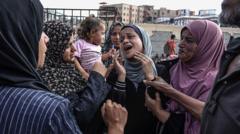How Many Lives Were Lost in Israeli Gunfire Near Gaza Aid Sites?

Understanding the Current Humanitarian Crisis in Gaza
The ongoing humanitarian crisis in Gaza has escalated dramatically, particularly in recent weeks. The situation has become increasingly dire, with reports indicating that at least 32 Palestinians seeking food were killed by Israeli gunfire near aid distribution points in southern Gaza. This alarming statistic highlights the severe risks faced by individuals attempting to access much-needed humanitarian assistance amidst a complex conflict. As aid distribution efforts are hindered, the implications for the local populace are catastrophic, leading to widespread suffering and a critical need for international attention.
The Role of Aid Distribution Points
In regions like Khan Younis and Rafah, the establishment of aid distribution points by organizations such as the Gaza Humanitarian Foundation (GHF) is crucial. However, the recent incidents of violence have raised questions about the safety and effectiveness of these operations. Eyewitness accounts suggest that the Israeli Defense Forces (IDF) engaged in targeted gunfire, with implications that the safety of civilians was not a priority. This situation not only affects those directly involved but also reflects on broader humanitarian efforts in conflict zones.
Eyewitness Accounts Highlighting the Dangers
Eyewitness reports are critical in understanding the ground realities in Gaza. One individual recounted a harrowing experience where a group of Palestinians, believing the GHF aid distribution center was operational, faced aggressive military action instead. The stark contrast between the expectation of safety at aid sites and the reality of violence further emphasizes the precarious nature of humanitarian efforts in the area.
The GHF's Operations and Controversies
The GHF operates under a controversial framework, utilizing private security contractors to manage aid distribution. While Israel and the US argue that these measures are necessary to prevent Hamas from misappropriating aid, the UN has raised ethical concerns about this approach. The refusal of the UN to collaborate with the GHF highlights the deep-seated mistrust and complexity of the humanitarian situation in Gaza. Critics argue that this model complicates an already difficult scenario for civilians who are in desperate need of assistance.
Statistics and Humanitarian Impact
The scale of the humanitarian crisis is underscored by alarming statistics. As of mid-July, the UN reported 674 killings in proximity to GHF sites, alongside an additional 201 fatalities linked to UN and other aid convoy routes. These figures paint a grim picture of the ongoing violence that civilians face, further exacerbating an already dire humanitarian situation. The recent spike in malnutrition cases, particularly among children, signals a critical health crisis that requires urgent intervention.
Malnutrition and Child Mortality Rates
The health implications of the crisis are severe, with reports indicating that the number of acutely malnourished children has doubled since restrictions on food supplies were enforced in March. The death of 69 children from malnutrition starkly illustrates the human cost of ongoing conflict and restrictions. Field hospitals report unprecedented numbers of patients suffering from severe exhaustion and malnutrition, showcasing the urgent need for comprehensive humanitarian support.
The Political Landscape and Its Impact on Humanitarian Aid
The political dynamics surrounding the Gaza conflict significantly impact humanitarian efforts. Despite claims from international leaders, such as US President Donald Trump, suggesting that a ceasefire deal may be imminent, on-the-ground realities tell a different story. Palestinian officials report that negotiations remain stalled, with unacceptable conditions posed by Israel. This political impasse complicates the delivery of aid and exacerbates the suffering of civilians.
International Response and Humanitarian Efforts
International response to the Gaza crisis has been mixed, with various organizations attempting to provide relief amid the chaos. However, the ongoing violence and political complexities often hinder these efforts. The refusal of organizations to cooperate with the GHF, coupled with the IDF's military actions, creates a challenging environment for humanitarian organizations trying to deliver aid effectively. It raises questions about the adequacy of current strategies and the need for a reevaluation of approaches to aid distribution in conflict zones.
Conclusion: The Path Forward for Humanitarian Aid in Gaza
The humanitarian crisis in Gaza showcases a complex interplay of violence, politics, and the dire need for aid. As the situation evolves, the necessity for a comprehensive approach to humanitarian assistance becomes increasingly clear. The international community must grapple with the realities on the ground and work towards a solution that prioritizes the safety and well-being of civilians. With ongoing violence and deteriorating conditions, the need for immediate and effective action cannot be overstated.
FAQs
What are the main causes of the humanitarian crisis in Gaza?
The humanitarian crisis in Gaza is driven by a combination of ongoing conflict, military actions, and restrictions on food and medical supplies. Political dynamics further complicate the situation, leading to widespread suffering among the civilian population.
How does the GHF operate in Gaza?
The Gaza Humanitarian Foundation operates by utilizing private security contractors to distribute aid from designated sites. This approach has been met with controversy, as it raises ethical concerns and complicates interactions with other aid organizations.
What is the impact of malnutrition on children in Gaza?
Malnutrition has devastating effects on children, leading to severe health complications and increased mortality rates. The doubling of acutely malnourished children since March highlights the urgent need for food and medical assistance in the region.
As the situation in Gaza continues to unfold, how can the international community balance the need for security with the urgent humanitarian needs of civilians? #GazaCrisis #HumanitarianAid #ConflictResolution
```Published: 2025-07-19 13:28:06 | Category: technology



